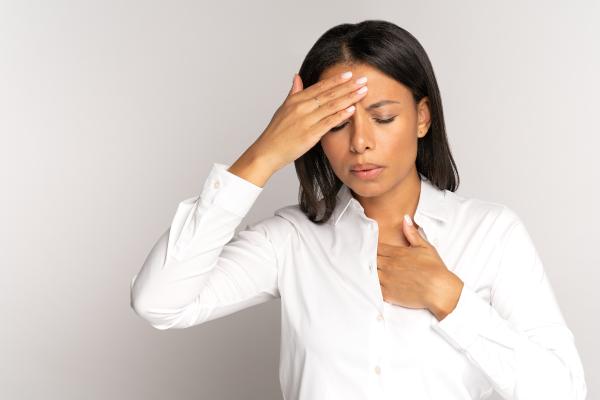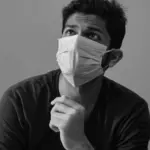The current times are truly stressful. Although it seems that the situation is improving, the truth is that the pandemic has turned the lives of many people upside down who are afraid of becoming infected.
Some symptoms of anxiety coincide with those of COVID-19, especially shortness of breath and pressure in the chest. As the fear of having the disease causes even more anxiety, those who are experiencing one of these episodes worry more, having even more difficulty breathing and feeling worse.
Taking this into account today we are going to see what they are the main differences between anxiety and respiratory problems associated with diseases in addition to seeing some ways to find out if you are facing an anxiety attack or not.
Main differences between anxiety and respiratory problems
Anxiety episodes are conditions that many people can suffer throughout their lives. Behind them there may be all kinds of causes that cause all kinds of symptoms in those who suffer from it, different in each person but which share as the main emotion experienced a deep fear and fear of how things will go.
The global pandemic is a serious enough problem to increase the number of cases of anxiety attacks. In addition to the fear of how society will develop in times after this crisis, there is the fact of being afraid of the virus itself, since the disease it causes is potentially fatal. Being a respiratory disease, COVID-19 can cause shortness of breath, a symptom that many people experience when they have an anxiety attack.
If we put ourselves in the shoes of a person who is experiencing an anxiety attack and taking into account that COVID-19 is the protagonist of current news, the fact that we begin to feel short of breath is something that will alert us very easily. . We will associate this difficulty breathing with the coronavirus, since it is the disease of the moment and the main danger. We will believe that we have been infected and that we are showing the first symptoms, that we will be just one step away from entering the ICU.
Believing this, the situation will get worse, since the more anxiety we will have, the more short of breath we will have and, the more we think about COVID-19 (or any other serious respiratory illness), the more anxiety we will have and, so on, until someone or something manages to calm them down. Having the coronavirus disease is not the only thing that damages our health, but so does constantly thinking about it and not knowing how to differentiate between anxiety and medically caused respiratory problems.
It is for all this that, with the intention of helping all those people who have ever suffered an anxiety attack, below we will see the similarities and differences between excess anxiety and respiratory problems.
Symptoms of anxiety and respiratory problems
First of all, let’s know what the symptoms of anxiety are. This problem does not manifest itself in the same way in all people since, just as we have different personalities, intelligence and abilities, our way of manifesting a psychological problem is also different. However, what coincides in all cases where there is an anxiety attack is an irrational fear and fear, especially not knowing how the episode will end or thinking that a potentially dangerous situation is occurring.
In the current context, concern about the virus is normal and it is natural for people to be very stressed. Added to the fear of catching the virus is the uncertainty of how all this will end, the economic and social repercussions it is implying and whether the “new normal” will end up being the future “normal”, a world in which it will be difficult to adapt. .
Thinking about all this is something that can cause an anxiety attack in all types of people, especially those who have a neurotic personality or an anxiety disorder. Among the symptoms that we can find in a condition of this type we have:
Taking COVID-19 as an example respiratory disease, among its primary symptoms we can find the following three.
Other less common symptoms of this disease are:
Distinguishing between both alterations
Looking at the symptoms of both problems, we can see that what an anxiety attack and COVID-19 coincide with are breathing difficulties, although their severity is different.
It is clear that If you are suffering from an anxiety attack, you are having a problem and the ideal thing is to consult with a psychologist. to acquire the best coping strategies; This already gives us one of the differences to differentiate between both alterations: anxiety is a psychological phenomenon that in most cases does not have organic causes, while respiratory problems are linked to physical alterations.
But perhaps the most notable difference between the two is the fever. Although this symptom can occur in very extreme cases of anxiety attacks, this is something very strange, while in the case of diseases caused by pathogens such as viruses and bacteria, it is common that in addition to not being able to breathe well , raise body temperature.
Another clearer distinction is runny nose. In respiratory problems in general, it is common for there to be excessive mucus production , while in an anxiety attack this does not happen. It may happen that the person who is experiencing an attack of this type has a cold and has a lot of runny nose, but it will not be anxiety that causes them, but rather the respiratory problem itself.
Another aspect in which anxiety and respiratory problems differ is in their duration. A panic attack that includes difficulty breathing can last between 20 and 30 minutes, peaking after about 10 minutes. On the other hand, breathing difficulties associated with a respiratory disease, whether mild like a cold or serious like the coronavirus itself, have a varied duration depending on the medical problem in question, but last at least several days.
How do you know if it is anxiety or a respiratory illness?
Naturally, the best people to diagnose respiratory diseases are doctors, while the best people to detect an anxiety attack are psychologists. However, it is useful to know what to do to distinguish between these two problems without having to go to a hospital and, on the one hand, give doctors more work than necessary and, on the other, risk becoming infected.
In addition to taking into account the differences mentioned above, What we can do to see if we really have a respiratory problem is the following exercise :
- Sit or lie down with your back straight
- Exhale completely through your mouth
- Close your mouth slightly and inhale through your nose for a count of four.
- Hold your breath and count to seven
- Exhale audibly through your mouth and count to eight
- Repeat steps 3 to 6 three more times for four breathing cycles.
If we have been able to do this exercise without feeling short of breath, it is most likely that we have had an anxiety attack. In people who suffer from a respiratory disease, it is not possible to complete the exercise, since the lungs are too affected. and breathing difficulties worsen over a short period of time.
Likewise, given the exceptional nature of the situation in which we find ourselves, regional and state governments and different health organizations have made telephone numbers available to users with which they can contact people who, without needing to go to the doctor , can inform us if we may have the disease. If you have not been able to complete the breathing exercise we just mentioned, it is best to seek urgent medical help.
Bibliographic references:
- Solomon, C. (2015). Generalized Anxiety Disorder. The New England Journal of Medicine, 373(21), pp. 2059 – 2068.
- Sylvers, P.; Lilienfeld, S.O.; LaPrairie, J.L. (2011). Differences between trait fear and trait anxiety: implications for psychopathology. Clinical Psychology Review. 31(1): pp. 122 – 137.
- Wu, J. (2015). Episodic future thinking in generalized anxiety disorder. Journal of anxiety disorders, 36, pp. 1 – 8.
- European Center for Disease Prevention and Control. (2020) “Outbreak of acute respiratory syndrome associated with a novel coronavirus, China; First cases imported in the EU/EEA; second update”. ECDC.









